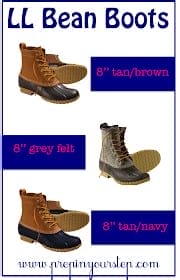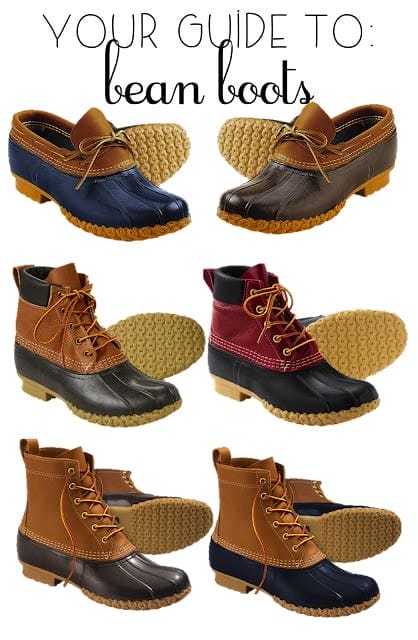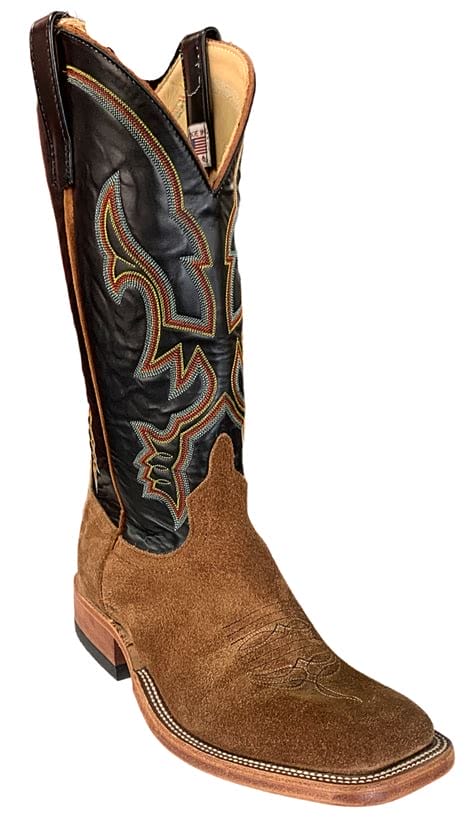The L.L.Bean Boot is designed to provide ample space for insulation during cold weather. If you prefer to wear light or midweight socks, it is recommended that you order one size down from your regular size if you wear a whole size.
For those who wear a half size, it is suggested to order one and a half sizes down. For instance, if you typically wear a 9 or 9½, it is best to order a size 8. This will ensure a comfortable fit that is suitable for your needs.
Does L.L. Bean run large or small?
When it comes to clothing, sizing can vary depending on the item. For instance, shirts and pants usually fit true to size or may even run a bit larger. However, jackets can often run small. To avoid any confusion or disappointment, it’s always a good idea to consult the sizing chart before making a purchase.
This will help ensure that you get the right size and a comfortable fit.
Do you want boots to be a little bigger?
When it comes to finding the perfect fit for your boots, it’s important to strike a balance between comfort and support. Your boots should not be too loose or too tight, as this can cause discomfort and even lead to foot problems over time. Instead, aim for a snug fit that allows for some movement in your toes and a bit of slippage at the heel. Ideally, you should have no more than a quarter to a half-inch of space between your heel and the back of the boot.
By finding the right fit, you can ensure that your boots provide the support and protection you need without sacrificing comfort.
What size is the big L.L. Bean boot?
At the forefront of L.L. Bean’s flagship store stands a 16-foot-tall boot with a rubber bottom, sized at a whopping 410. This quirky attraction has become a popular spot for visitors to snap a photo, but it’s not just for show.
Inside the store, you can purchase a regular-sized pair of boots to experience the quality and durability that L.L. Bean is known for.
Do L.L. Bean boots come in half sizes?
LL Bean Boots – Finding the Right Size:
When it comes to LL Bean Boots, finding the right size can be a bit tricky. Even if you’ve been a consistent size in every other shoe, you may need to size down for these boots. For example, if you’re typically a size 8, you may find that a size 7 fits you best in Bean Boots. It’s worth noting that they don’t offer half sizes, so sizing down a full size is often the best option.
This is something to keep in mind when ordering your boots to ensure a comfortable fit. Don’t be surprised if you need to go down a size or two!
Should I order boots a half size bigger?
When it comes to choosing the right size of boots, it’s important to consider the season and the width of your feet. For summer use, it’s recommended to go half a size bigger than your shoe size, while for winter use, it’s best to stick to the same size. If you have wider feet than average, it’s advisable to opt for a larger size to ensure there’s enough space. Additionally, make sure that your toes are positioned around 1 inch to 0.
5 inches away from the toe cap of the boot for optimal comfort.
Should you go up half a size in winter boots?
If you’re wondering whether snow boots tend to run big or small, or if you’re considering sizing up to accommodate thick socks, you may be overthinking it. The truth is, you should stick to your regular shoe size. Going up a size may actually cause your feet to slide around inside the boots, leading to discomfort and even blisters. So, save yourself the hassle and stick with what you know works for you.
Is it better to size up or down in boots?
It’s important to keep in mind that when buying boots, you may need to go a half size down from your usual shoe size. It’s always a good idea to check with the manufacturer to see if this is the case for their specific brand before making a purchase. This can help ensure a better fit and prevent discomfort or blisters from wearing boots that are too big.
Is it OK to wear boots half a size too big?
Are you wondering if it’s acceptable to wear boots that are a size too big? The answer is yes, as long as you take measures to keep your foot in place. You can use insoles or heel shields to secure your foot and prevent it from sliding around in the boot. However, if your heels are slipping and the flex points are misaligned, it’s not okay. This can lead to painful blisters, inflammation, and even plantar fasciitis.
It’s important to ensure that your boots fit properly to avoid any foot-related issues.
Is it bad to wear boots a half size too big?
Wearing shoes that are too big can result in blisters and foot pain. When your feet slide around inside the shoes, it creates friction that can cause blisters to form. This can be particularly troublesome if you spend extended periods walking or standing.
How do I know my boot size?
To determine your boot size, you should measure your foot length and width. Use a ruler or tape measure to measure the length of your foot from the heel to the longest toe. Then, measure the width of your foot at the widest point. Compare your measurements to a size chart provided by the boot manufacturer to find your size.
It’s important to note that different brands may have slightly different sizing, so it’s always best to try on boots before purchasing if possible. Additionally, consider the type of socks you will be wearing with the boots and if you have any foot conditions that may require a specific fit.
Do boots stretch over time?
It’s worth noting that many people advise against buying boots with the expectation that they will stretch. While this is generally a good rule to follow, it’s important to keep in mind that most boots will stretch slightly, usually only by about a millimeter.
How do you know if boots are too small?
If you’re experiencing discomfort in your toes, it could be a sign that your shoes are too tight. One way to check is by placing a finger behind your ankle and seeing if your toes feel jammed. Another method is to put on your shoes, stand up straight, and try wiggling your toes. If they don’t move easily, your shoes are likely too tight.
To be sure, we suggest walking around in them for a minute or two to see if the discomfort persists.
Should boots be a little tight at first?
When it comes to finding the perfect fit for your boots, it’s important to ensure that they are snug in the instep area of your foot. This means that they should not be too tight across the ball of your foot or toes, but rather feel like a comfortable handshake. While a new boot may slip slightly when it’s brand new, as long as it’s snug in the instep, this slip will eventually come out as you wear them and they flex. So, take the time to find the right fit and enjoy the comfort and support that a well-fitted boot can provide.
How much toe room should you have in boots?
When trying on shoes, it’s important to ensure that there is enough space for your toes to move around comfortably. To check if there is sufficient room, slide your foot forward so that your toes are touching the end of the unlaced shoe. At this point, you should be able to wiggle your toes inside the toe box and there should be about half an inch of space between the base of your heel and the shoe. This will help prevent any discomfort or pain caused by cramped toes or a tight fit.
Should my toes touch the end of my shoes?
In terms of shoe fitting, it’s recommended to have approximately one finger’s width of room between your longest toe and the end of the shoe. Alternatively, you can also check by placing a finger between the heel of your foot and the back of the shoe. The ideal fit should allow for a snug and comfortable fit with just enough space for your finger to fit in.
Is it OK to wear boots half a size too big?
Are you wondering if it’s acceptable to wear boots that are a size too big? The answer is yes, as long as you take measures to keep your foot in place. You can use insoles or heel shields to secure your foot and prevent it from sliding around in the boot. However, if your heels are slipping and the flex points are misaligned, it’s not okay. This can lead to painful blisters, inflammation, and even plantar fasciitis.
It’s important to ensure that your boots fit properly to avoid any foot-related issues.
Can you make boots a half size smaller?
Are you stuck with a new pair of shoes or boots that are too big? Returning them may not be an option, but don’t worry, there are still ways to make them fit comfortably. Unfortunately, a cobbler can’t make most types of shoes smaller, but there are other solutions. Heel grips, gel pads, thick insoles, and toe inserts are all great options to help fill the extra space and provide a better fit. With these simple addons, you can enjoy your new shoes without any discomfort.
Do you size up in work boots?
It’s important to avoid trying to fit into regular boot sizes if you have wider feet. Even if the larger boots seem to fit the width of your foot, they will likely be too long and cause discomfort such as blisters, chafing, and heel slippage. Instead, opt for boots that are naturally designed in wide sizes, such as the MILOW safety shoe. This will ensure a comfortable fit and prevent any unnecessary foot pain.
What does 8.5 D mean in boots?
When it comes to buying boots, it’s important to consider the width of your feet. Luckily, most boots come in a variety of widths to accommodate different foot sizes. The six standard widths are B for extra narrow, C for narrow, D for regular, E for wide, EE for extra wide, and EEE for triple wide. It’s crucial to find the right width to ensure a comfortable fit and prevent any discomfort or pain.
So, be sure to measure your feet and try on different widths to find the perfect fit for you.
Related Article
- Are Lk Bennett Dresses True To Size?
- Are Liverpool Jeans True To Size?
- Are Lipsy Dresses True To Size?
- Are Lined Crocs True To Size?
- Are Lilly Pulitzer Dresses True To Size?
- Are Light In The Box Clothes True To Size?
- Are Life Is Good Shirts True To Size?
- Are Levis Wedgie Jeans True To Size?
- Are Levi’S True To Size Reddit?
- Are Levi’S True To Size?


